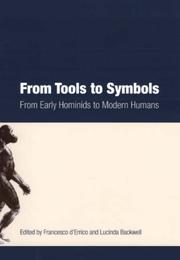| Listing 1 - 6 of 6 |
Sort by
|
Book
ISBN: 9728662157 Year: 2003 Volume: 33 Publisher: Lisboa : Instituto portugues do patrimonio cultural, departamento de arqueologia,
Abstract | Keywords | Export | Availability | Bookmark
 Loading...
Loading...Choose an application
- Reference Manager
- EndNote
- RefWorks (Direct export to RefWorks)
Aurignacian culture --- Chatelperronien culture --- Tools, Prehistoric --- Stone implements --- Bone implements --- Excavations (Archaeology) --- Aurignacien --- Chatelperronien --- Outils préhistoriques --- Outils de pierre --- Outils d'os préhistoriques --- Fouilles (Archéologie) --- Congresses. --- Congrès --- Eurasia --- Eurasie --- Antiquities --- Antiquités --- Outils préhistoriques --- Outils d'os préhistoriques --- Fouilles (Archéologie) --- Congrès --- Antiquités --- Implements, Prehistoric --- Implements, utensils, etc., Prehistoric --- Prehistoric implements --- Prehistoric tools --- Flint implements --- Lithic implements --- Implements, utensils, etc. --- Debitage --- Archaeological digs --- Archaeological excavations --- Digs (Archaeology) --- Excavation sites (Archaeology) --- Ruins --- Sites, Excavation (Archaeology) --- Archaeology --- Castelperronien culture --- Chatelperron culture --- Paleolithic period --- Cro-Magnons --- Asia --- Europe
Book
ISBN: 9781776146642 9781776146628 1776146646 9781776146659 1776146654 Year: 2021 Publisher: Johannesburg : Wits University Press,
Abstract | Keywords | Export | Availability | Bookmark
 Loading...
Loading...Choose an application
- Reference Manager
- EndNote
- RefWorks (Direct export to RefWorks)
This richly illustrated book documents San material culture through the words of four San elders in conversation with two academics. Their discussion, over seven days, of the world's largest collection of San artefacts provides a novel perspective that enriches scholarly knowledge and brings past and present San ways of life vividly alive.
Book
ISBN: 9789027211897 9789027284099 9786613314710 9027284091 1283314711 9781283314718 9027211892 Year: 2011 Publisher: Amsterdam ; Philadelphia : J. Benjamins Pub.,
Abstract | Keywords | Export | Availability | Bookmark
 Loading...
Loading...Choose an application
- Reference Manager
- EndNote
- RefWorks (Direct export to RefWorks)
The emergence of symbolic culture, classically identified with the European cave paintings of the Ice Age, is now seen, in the light of recent groundbreaking discoveries, as a complex nonlinear process taking root in a remote past and in different regions of the planet. In this book the archaeologists responsible for some of these new discoveries, flanked by ethologists interested in primate cognition and cultural transmission, evolutionary psychologists modelling the emergence of metarepresentations, as well as biologists, philosophers, neuro-scientists and an astronomer combine their researc
Symbolism (Psychology) --- Human behavior. --- Language and languages --- Psycholinguistics. --- Biolinguistics. --- Origin. --- Biology --- Linguistics --- Language, Psychology of --- Psychology of language --- Speech --- Psychology --- Thought and thinking --- Origin of languages --- Action, Human --- Behavior, Human --- Ethology --- Human action --- Human beings --- Human biology --- Physical anthropology --- Social sciences --- Psychology, Comparative --- Symbolism in psychology --- Psychoanalysis --- Psychological aspects --- Origin --- Behavior

ISBN: 1868144178 1868144348 1868146375 Year: 2005 Publisher: Johannesburg Wits University Press
Abstract | Keywords | Export | Availability | Bookmark
 Loading...
Loading...Choose an application
- Reference Manager
- EndNote
- RefWorks (Direct export to RefWorks)
A number of researchers have tried to characterise the anatomy and behavioural systems of early hominid and early modern human populations in an attempt to understand how we became what we are. Can archaeology, palaeo-anthropology and genetics tell us how and when human cultures developed the traits that make our societies different from those of our closest living relatives? In which cases are these differences substantial, and when do they simply reflect our definitions of culture, species, the image we have of their evolution or of ourselves? From Tools to Symbols, a collection of twenty-seven selected papers from a South African-French conference organised in honour of the well-known palaeo-anthropologist Phillip Tobias, provides a multidisciplinary overview of this field of study. It is based on collaborative research conducted in sub-Saharan Africa by South African, French, American and German scholars in the last twenty years, and represents an excellent synthesis of the palaeontological and archaeological evidence of the last five million years of human evolution.
Hominids --- Paleoclimatology --- Hominidés --- Paléoclimatologie --- Tobias, Phillip Vallentine --- Tobias, Phillip V. --- Festschrift - Libri Amicorum --- Hominidés --- Paléoclimatologie --- Geologic climate --- Palaeoclimatology --- Paleoclimate --- Climatic changes --- Climatology --- Great apes --- Hominians --- Hominidae --- Homininae --- Hominins --- Homonids --- Man-like primates --- Pongidae --- Apes --- Primates --- Tobias, P. V.
Book
ISBN: 9782951873513 Year: 2023 Publisher: Carcassonne : Groupe Audois d'Études Préhistoriques,
Abstract | Keywords | Export | Availability | Bookmark
 Loading...
Loading...Choose an application
- Reference Manager
- EndNote
- RefWorks (Direct export to RefWorks)
Le décor gravé de la grotte Gazel se développe sur les parois d'une petite galerie plongée dans l'obscurité. En partie détruit par l'altération des supports, ou masqué par des coulées de calcite, il a fait l'objet d'une étude approfondie sous la conduite de l'auteur. Parmi la vingtaine de figurations animales spécifiquement déterminées, les chevaux devancent largement les bouquetins. Au nombre des motifs géométriques, les clatriformes, trouvent leurs homologues sur des plaquettes gravées mises au jour dans l'aire d'occupation magdalénienne contenue dans un autre secteur de la cavité. Cette galerie ornée appartient tout à la fois au groupe, majoritaire, des sites de petites dimensions et à celui, moins nombreux, des " sanctuaires " contigus à de vastes lieux de rassemblements périodiques
Antiquités --- Art pariétal --- Magdalénien


ISBN: 2735108856 2735118681 Year: 2017 Publisher: Paris : Éditions de la Maison des sciences de l’homme,
Abstract | Keywords | Export | Availability | Bookmark
 Loading...
Loading...Choose an application
- Reference Manager
- EndNote
- RefWorks (Direct export to RefWorks)
Les sites archéologiques de la vallée de l'Indus en témoignent : l'artisanal des perles en cornaline remonte à plusieurs millénaires. De nos jours, il se pratique encore dans quelques rares endroits comme en Inde dans la ville de Cambay (Gujarat) qui offre au chercheur une occasion unique de construire des référentiels. Dans ce but, des méthodes d'enquête appropriées ont été élaborées. Elles aboutissent à des régies interprétatives portant sur les processus techniques, les habiletés de taille, le techno-système. Il s'ensuit une interprétation des perles de l'Indus et de la Mésopotamie en termes de production et de réseaux de distribution. Interprétations fondées qui permettent de nouvelles hypothèses sur la fonction de certaines perles et sur les conditions de leur apparition. L'ouvrage est accompagné d'un cédérom (Mac-PC). La totalité des constructions scientifiques y est présentée selon un mode d'édition qui permet une lecture rapide des résultats ainsi que la consultation d'une très importante base de données (photos, films, graphiques, tableaux). The archaeological sites of the Indus Valley show that the craft of carnelian bead-making goes back several thousands of years. 'Ibday it is still racticed in a few rare places, such as the Indian city of Cambay (Gujarat), ofiering a unique opportunity for researchers to construct a modern reference base. With this objective in mind, appropriate investigative methods were developed. They have resulted in interpretative rules relating to technical processes, knapping skills, and the teclmo-system. These rules enable us to interpret the beadsfrom Indus and Mesopotamia in terms of production and distribution networks. These welltfounded interpretations allow the formulation of new hypotheses concerning thefitnction of certain beads and the conditions of their appearance. This book comes with a PC /Mac compatible CD-Rom. Scientific constntcts are presented in aformalized wayfin quick access to the main results as well as…
Indian handicrafts --- Beads --- Beadwork --- Indus civilization. --- Gems. --- History. --- India --- Antiquities. --- Harappa culture --- Harappan civilization --- Harappan culture --- Indus Saraswati civilization --- Indus Saraswati Valley civilization --- Indus Valley civilization --- Indus Valley culture --- Beading (Fancy work) --- Fancy work --- Inde --- vallée de l’Indus --- gemmes --- archéologie
| Listing 1 - 6 of 6 |
Sort by
|

 Search
Search Feedback
Feedback About UniCat
About UniCat  Help
Help News
News